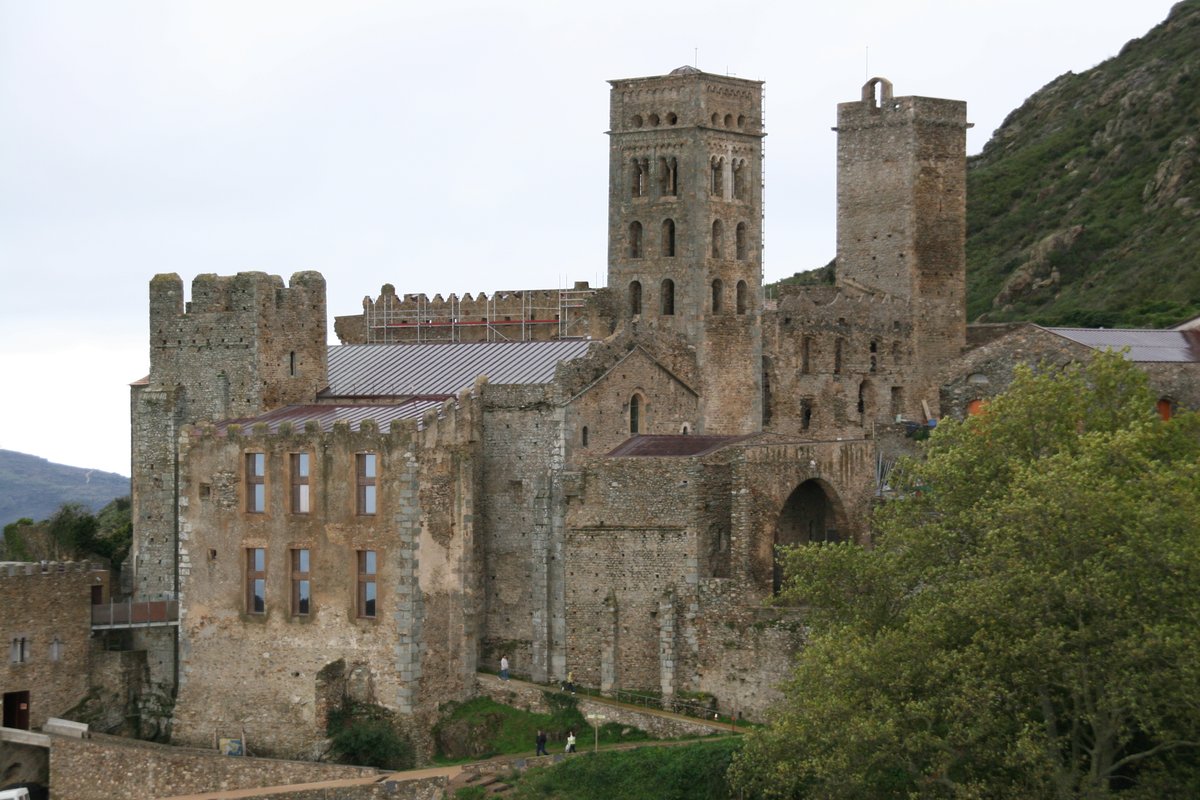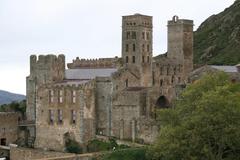
Visiting Hours, Tickets, and History of Monestir de Sant Pere de Rodes
Date: 18/07/2024
Introduction
Nestled on the Verdera mountain, overlooking the stunning Cap de Creus peninsula in Catalonia, the Monestir de Sant Pere de Rodes is a remarkable historical and architectural gem. This former Benedictine monastery not only boasts a captivating history but also serves as a testament to the region’s rich cultural heritage. With its origins shrouded in legend, some accounts link its foundation to the arrival of monks carrying the remains of Saint Peter from Rome in the 6th century. While this narrative remains debated, it is certain that by the 9th century, a small monastic community had established itself on the Verdera mountain (Sant Pere de Rodes History).
The monastery’s fortunes surged dramatically under the patronage of the Counts of Empúries in the 10th century, transforming from a modest religious settlement into a powerful Benedictine abbey. Its architectural evolution reflects a captivating blend of Romanesque, Gothic, and even earlier elements, showcasing the monastery’s development over centuries. Visitors today can marvel at its magnificent church, a masterpiece of Catalan Romanesque architecture, and explore the sprawling monastic complex that includes the cloister, chapter house, refectory, and dormitory (Visitor Information Guide).
This comprehensive guide aims to provide an in-depth exploration of the Monestir de Sant Pere de Rodes, covering its historical significance, architectural wonders, and essential visitor information. Whether you’re an architecture enthusiast, history buff, or simply seeking a place of tranquility and reflection, this guide will enhance your experience at this historical gem in Catalonia.
Table of Contents
- Introduction
- Historical Significance and Architecture
- Visitor Information
- Exploring the Monastery
- Nearby Attractions
- Conclusion
- FAQ
Discover the Monestir de Sant Pere de Rodes - History, Architecture, and Visitor Information
Historical Significance and Architecture
Early Beginnings and the Rise of a Benedictine Powerhouse
The monastery’s origins are shrouded in legend, with some accounts linking its foundation to the arrival of monks carrying the remains of Saint Peter from Rome in the 6th century. While this narrative remains debated, it is certain that by the 9th century, a small monastic community had established itself on the Verdera mountain.
The monastery’s fortunes began to rise dramatically under the patronage of the Counts of Empúries in the 10th century. This period witnessed a surge in construction, transforming the modest religious settlement into a powerful Benedictine abbey. The monastery’s influence extended far beyond its mountaintop perch, accumulating vast landholdings and wielding significant political and economic clout.
Architectural Evolution - A Tapestry of Styles
The monastery’s architectural fabric reflects its long and storied past, showcasing a captivating blend of Romanesque, Gothic, and even earlier architectural elements. This fusion of styles is a testament to the monastery’s evolution over centuries, with each era leaving its distinct mark on the edifice.
The Romanesque Heart of the Monastery
At the heart of the monastery lies its magnificent church, a masterpiece of Catalan Romanesque architecture. Constructed between the 10th and 11th centuries, the church’s imposing façade, with its intricate carvings and soaring bell tower, serves as a powerful symbol of the monastery’s former glory.
Stepping inside, visitors are greeted by a sense of grandeur and serenity. The church’s interior, characterized by its harmonious proportions, massive pillars, and rounded arches, evokes a sense of awe and reverence. The interplay of light and shadow, filtering through the small, high-set windows, adds to the mystical ambiance.
Beyond the Church - Exploring the Monastic Complex
Beyond the church, the monastery’s sprawling complex beckons exploration. The cloister, a tranquil oasis surrounded by graceful arches, offers a glimpse into the daily lives of the Benedictine monks who once inhabited these hallowed halls. The chapter house, where monks gathered for meetings and readings, stands as a testament to the monastery’s intellectual and spiritual pursuits.
Other notable structures within the complex include the refectory, where monks shared their meals in silence, and the dormitory, a long, austere chamber that housed the monastic community. These spaces, though now largely in ruins, offer a poignant reminder of the simple and disciplined lives led by the monks.
Decline, Abandonment, and Rediscovery
The monastery’s golden age began to wane in the late Middle Ages, plagued by pirate attacks and political instability. By the 18th century, the monastery was abandoned, its once-grand structures falling into disrepair.
However, the story of Sant Pere de Rodes doesn’t end there. The 20th century witnessed a renewed interest in the monastery’s historical and architectural significance. Extensive restoration efforts breathed new life into the ruins, allowing visitors to once again marvel at the splendor of this ancient site.
Visitor Information
Sant Pere de Rodes Visiting Hours and Tickets
- Visiting Hours: The monastery is open to visitors throughout the year, with varying hours depending on the season. Typically, it opens at 10:00 AM and closes between 5:30 PM and 7:00 PM. It’s advisable to check the official website for the most up-to-date visiting hours.
- Tickets: Entry tickets can be purchased on-site or online. Prices are generally affordable, with discounts available for students, seniors, and groups. Guided tours are also offered for those who wish to gain deeper insights into the monastery’s history and architecture.
Travel Tips
- Getting There: The easiest way to reach Sant Pere de Rodes is by car. The monastery is about a 30-minute drive from the town of Figueres. There is ample parking available at the site.
- Nearby Attractions: Combine your visit with a trip to the nearby Cap de Creus Natural Park or the charming coastal town of Cadaqués. Both are within easy reach and offer additional cultural and natural experiences.
- Accessibility: The site is partially accessible to visitors with mobility issues. While some areas may be challenging to navigate, efforts have been made to accommodate all visitors.
Special Events and Guided Tours
- Special Events: Throughout the year, the monastery hosts a variety of events, including concerts, exhibitions, and religious celebrations. These events offer unique opportunities to experience the site in a different light.
- Guided Tours: Expert guides are available to lead tours, providing fascinating insights into the monastery’s history, architecture, and the daily lives of the monks who once lived there. Tours can be booked in advance or upon arrival, subject to availability.
Exploring the Monastery
Allow Ample Time
Allocate at least 2-3 hours to fully explore the monastery complex, including the church, cloister, and museum.
Dress Code
As a place of worship, it’s respectful to dress modestly. Shoulders and knees should be covered when entering the church.
Photography
Photography is permitted for personal use, but flash photography and tripods are generally not allowed inside the buildings.
Accessibility
The monastery is partially accessible for visitors with disabilities. However, some areas, such as the upper levels and towers, may be difficult to access.
Nearby Attractions
Coastal Charms and Picturesque Towns
- Roses: The charming coastal town of Roses, just a short drive from the monastery, offers beautiful beaches, a lively promenade, and a picturesque harbor. Explore the historic Ciutadella de Roses, a 16th-century military fortress that houses a fascinating museum showcasing the town’s rich past (Visit Roses).
- Cadaqués: Further along the coast, nestled in a sheltered bay, lies the captivating town of Cadaqués. Known for its whitewashed houses, narrow cobblestone streets, and bohemian atmosphere, Cadaqués was a favorite haunt of artists like Salvador Dalí. Visit the Casa-Museu Salvador Dalí, the artist’s former home, for a glimpse into his eccentric world (Cadaqués).
- Cap de Creus Natural Park: This dramatic headland, jutting out into the Mediterranean, is a paradise for hikers and nature lovers. Follow the rugged coastal trails, marvel at the wind-sculpted rock formations, and soak in the breathtaking views of the sea and the Pyrenees Mountains (Cap de Creus Natural Park).
Wine Country and Medieval Villages
- Empordà Wine Region: Venture inland to discover the Empordà wine region, known for its distinctive wines produced from local grape varieties. Visit one of the many wineries dotting the countryside, sample the local vintages, and learn about the winemaking traditions of the region (Empordà Wine).
- Pals: Step back in time in the beautifully preserved medieval village of Pals. Wander through its labyrinthine streets, admire the Romanesque architecture, and climb the Torre de les Hores (Tower of the Hours) for panoramic views of the surrounding countryside (Visit Pals).
- Peratallada: Another captivating medieval village, Peratallada, enchants visitors with its cobbled streets, stone houses adorned with colorful flowers, and charming squares. Explore the castle, wander through the artisan shops, and enjoy a leisurely meal in one of the village’s inviting restaurants (Peratallada).
Further Afield - Exploring Girona and Beyond
- Girona: The historic city of Girona, located approximately an hour’s drive from the monastery, is well worth a visit. Explore the well-preserved Jewish Quarter, wander along the Onyar River, crossed by colorful bridges, and visit the Girona Cathedral, home to a magnificent Romanesque tapestry (Girona Tourism).
- Figueres: Birthplace of Salvador Dalí, Figueres houses the Teatre-Museu Dalí, a surrealist masterpiece designed by the artist himself. This museum offers a fascinating and often bizarre journey through Dalí’s artistic evolution (Dalí Theatre-Museum).
- Aigüamolls de l’Empordà Natural Park: This important wetland area provides a haven for a diverse array of birdlife. Explore the park’s trails, observe the resident and migratory birds, and learn about the importance of wetland conservation (Aigüamolls de l’Empordà).
FAQ
Q: What are the Sant Pere de Rodes visiting hours? A: The monastery is typically open from 10:00 AM to 5:30 PM or 7:00 PM, depending on the season. Check the official website for the latest information.
Q: How much are the Sant Pere de Rodes tickets? A: Ticket prices vary, with discounts available for students, seniors, and groups. Guided tours are an additional cost.
Q: Are there guided tours available? A: Yes, guided tours are available and can be booked in advance or on-site.
Q: Is the monastery accessible to visitors with mobility issues? A: The site is partially accessible, with some areas being more challenging to navigate.
Conclusion
The Monestir de Sant Pere de Rodes stands as a testament to Catalonia’s rich cultural heritage. Its weathered stones whisper tales of a bygone era, inviting visitors to step back in time and immerse themselves in the monastery’s captivating history. Whether you’re an architecture enthusiast, a history buff, or simply seeking a place of tranquility and reflection, a visit to Sant Pere de Rodes is an experience that will stay with you long after you’ve descended the mountain. For more travel tips and updates, follow us on social media or download our mobile app Audiala.
References
- Discover the Monestir de Sant Pere de Rodes - History, Architecture, and Visitor Information, 2024, https://www.monestirsantpere.cat/en
- Monestir de Sant Pere de Rodes - Visitor Information, Tickets, and Travel Tips for Exploring Roses’ Historical Gem, 2024, https://www.visit.roses.cat/en
- Exploring Catalonia - Must-Visit Cultural and Natural Attractions Near Sant Pere de Rodes, 2024, https://www.catalunya.com/



